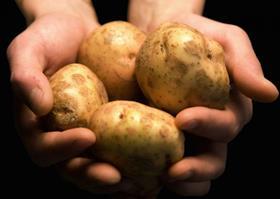
Last year supply was tight on the UK potato market with a lower-quality crop creating storage problems and a decrease in planted area. This year the sector looks set to face the opposite problem: oversupply.
White potatoes have seen an increase in area of around 12 per cent, according to potato supplier Branston, and this reflects a wider 4.6 per cent increase in planted area across all potato types in the UK, Belgium, France, Germany and the Netherlands. Britain’s potato cultivation area grew by four per cent to 103,200 hectares this year, according to estimates from the Northwest European Potato Producers group in June.
“Most crop groups are in a depressed mode at the moment, partly driven by the excess that was marketed at the very end of last season at very low prices, and subsequently by the knowledge that we have an increased area planted, especially in fresh potatoes,” explains Branston’s communications manager Jackie Baker.
This makes oversupply a real possibility and, as Baker says, there is unlikely to be demand from Europe due to the additional volumes they have grown too. The greatest increase in planted area, announced by the Northwest European Potato Producers, was in Belgium, where growing area climbed 5.4 per cent to more than 96,000ha.
In the UK, Kantar data for the 52 weeks to 10 September shows that the average price per kg has fallen from 83p to 81p, contributing to a year-on-year value sales decrease of 1.2 per cent, despite the fact that volumes inched up 0.7 per cent. In the last quarter, however, the market has returned to positive value and volume growth – a trend that Greenvale’s customer operations director Andy Clarkson puts down to “a mix of reinvigorated promotions and range changes” at the major retailers.
It should also be noted that recent growing conditions could help redress the balance in supply and pricing – even if it does mean a reduction in yields. “The current conditions in parts of the country are concerning as we have had significant rainfall in the last few weeks, making harvesting conditions extremely difficult,” says Baker. “Currently supply is not affected, but this may become an issue if the rain continues.”
With crop estimates based upon trial digs and crop monitoring for the time being, “the true picture will become more apparent as we move into late October and more crop is lifted,” Clarkson adds.
Against this backdrop of price deflation, value sales in various sub-sectors of the potato category have remained buoyant – particularly in varieties that are quick to cook and easy to prepare. Sales of baking potatoes have risen 3.4 per cent to £7m, reflecting consumers’ desire for products that require minimal preparation, while new and mini potatoes (excluding baby varieties) have enjoyed the strongest sales growth, up 9.5 per cent year on year, according to Nielsen data. “A key barrier to purchase is preparation, so small potatoes that do not need peeling and are quick to cook meet the needs of our busy lifestyles,” explains Baker.
In addition, Greenvale reports that premium-tier potatoes are continuing to bring sales growth, with more shoppers choosing to trade up. “Our Red Fantasy potatoes, which launched into the Tesco Finest Red Potato pack in 2016, are showing strong growth,” says Clarkson. “And our Sainsbury’s Taste the Difference British Gems, which are harvested and delivered to store within 48 hours, have had a positive 2017 season.” Seasonal potatoes have also sold particularly well in 2017, with the Jersey Royal Company enjoying value sales rises of 8.8 per cent this season.
In terms of new varieties, the Greenvale launched a new maincrop potato called Lilly into the Co-op Irresistible Mashing pack this month and is set to begin sales of the next generation of its Mayan Gold variety, Mayan Rose, in November at Tesco. The phureja potato, which originates from the Andes in South America, will be used in the Tesco Finest Roasting Pack. It has a buttery flavour and golden flesh, due to its unusually high level of carotene, Clarkson says.



